MEDIEVAL CITIES
AVILA, SPAIN
JAISALMER, INDIA
AVILA , City of Knights
The extensive history of Avila begins with the primitive Celt Iberian settlement of the Vetoes around 700 B.C. The first wall was built with the arrival of the Romans in the third century B.C., making Avila a strategic point of defence. Following several centuries of decadence, the city was repopulated and rebuilt in the 11th century
The legend says that Raimundo de Borgoña, son-in-law of King Alfonso VI, was in charge of supervising the reconstruction of the wall on top of the ruins of the ancient Roman fortress. The peak period of the city would come in the 16th century, when wool manufacture would allow its economic take-off. During this boom, many civil and religious buildings were built in the city, which still stand in the historic quarter.
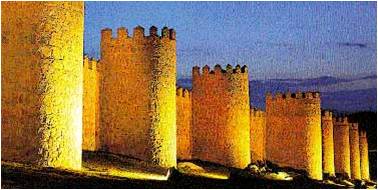
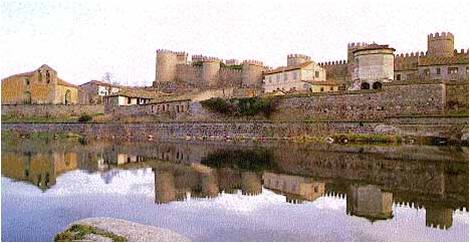
The wall is the symbol of the city and it is one of the best kept, medieval walled enclosures in Europe. Its two and a half kilometre perimeter is marked by almost 2,500 crenellations, a hundred towers, six gates and three openings.

The Gate of Leales, one of the main entrances into the ancient city, leads directly to the cathedral, a temple which resembles a fortress, erected between the 12th and 14th centuries and the apse of which, called “cimorro”, is attached to the wall, making it the largest round turret of the whole bastion. While Gothic and Baroque elements overlap in the façade, in the interior the elaborated relieves of the retrochoir and the alabaster sarcophagus of El Tostado are astounding. The Diocesan Museum has numerous art pieces, among which a monumental processional monstrance should be highlighted, work by Juan de Arfe.
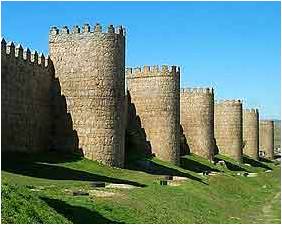
Within the confines of the wall, medieval corners such as the Plaza de los Dávila intermingle with more than a dozen Renaissance houses of noble lineage, among which it is worth mentioning the Mansion of Velada, the Palace of Valderrábano and the Palace of Núñez Vela. But the most remarkable building is the Palace of Dávila. It is a severe fortress made up of four houses, the oldest of which dates back to the 13th century. The compound stands out for its crenellations and its famous Renaissance window.
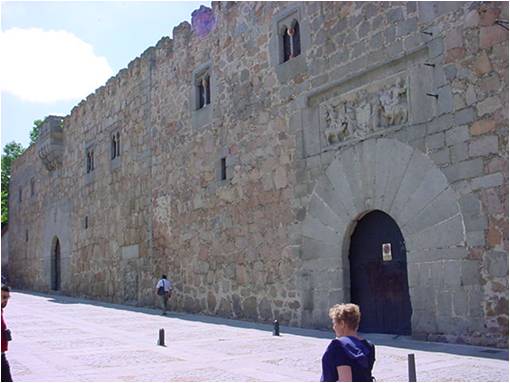
Palace of Dávila.
Nearby stands the Tower of Guzmanes, erected in the 16th century and that presently houses the City Council. These are only a few of the more than a hundred mansions and palatial residences that existed in Avila between the 16th and 18th century, which can be seen in the full name of the city: Avila de los Caballeros, or Avila of the Noblemen. The square of Mercado Chico, the place where the ancient Roman forum stood, is now the city centre. The front of the City Hall faces it, as does the façade of the church of San Juan, rebuilt between the 15th and the 16th centuries.
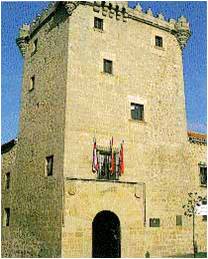
Tower of Guzmanes
Throughout history, Avila was the birthplace of famous Spanish mystics, like Santa Teresa de Jesús and San Juan de la Cruz. This is evidenced by the great number of churches and convents that are scattered around the city. In Plaza de Santa Teresa is the convent under the same name, built in 1636 on top of the house where Santa Teresa del Jesús was born. The building, with a Baroque main front, houses an important collection of carvings made by sculptor Gregorio Fernández, in addition to a chapel, remarkable for its profuse ornamentation, devoted to the Saint. In the interior there is an orchard where, according to the legend, the mystic of Avila played as a child.
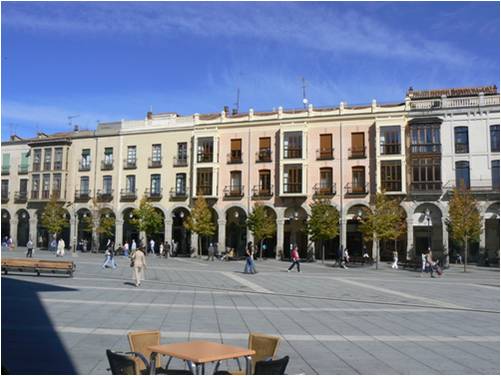
Plaza de Santa Teresa
Avila beyond the confines of the wall
Beyond the confines of the walled enclosure sits the monastery of Encarnación, erected in the 16th century and where Santa Teresa lived as a nun for more than 20 years. Inside it, is worth stopping at the places that the writer frequented, such as her cell or the chapel of Transverberation.
Another remarkable building is the Basilica of San Vicente, erected in the 12th century next to the site where three Saints were martyred during times of the Roman emperor Diocletianus. This temple is considered to be the most beautiful example of Romanesque architecture in the city, even though it incorporates architectural elements that were added during later periods. The exterior of the building is dominated by three magnificent apses, the western front, also known as the Portico of the Glory of Avila and the southern façade. The interior is graced with beautiful vaults and the sarcophagus of San Vicente, an important funerary monument attributed to master Fruchel. Behind the basilica sits the church of San Andrés, a Romanesque building that holds in its interior the most important decorated capitals of those still preserved in the city.
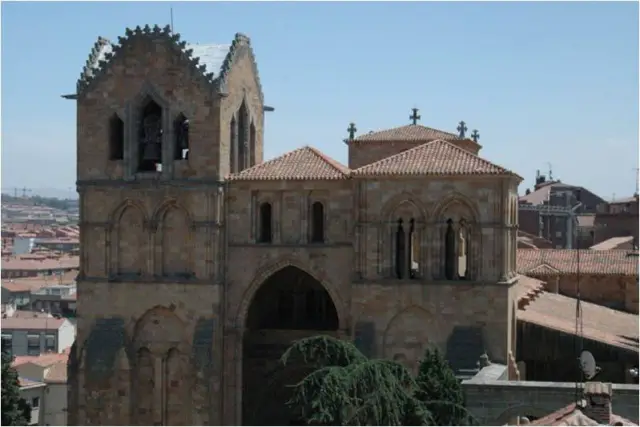
Basilica of San Vicente
Also from the Romanesque period is the church of San Pedro, one of the oldest in Avila, dating back to the 12th and 13th centuries. The sobriety that characterised this building attracted the most relevant figures of Avila for centuries. The most remarkable elements from the outside are a great Cistercian rose window in the main frontand three apses. From the inside, the scant ornamentation contrast with the interesting series of paintings and reredos.
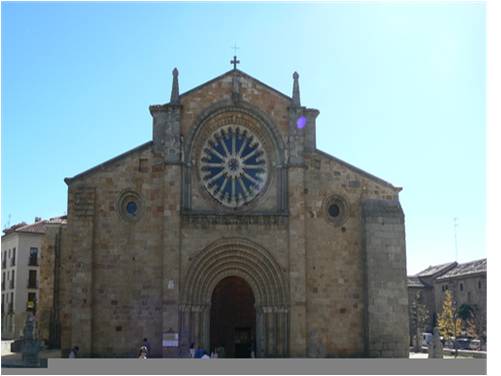
Iglesia de San Pedro, Avila
This church is in Plaza de Santa Teresa, at the opposite end to Puerta del Alcazar.
Beyond the confines of the walls, though near the Gate of Leales, stands the Palace of the Deans. Originally, as its name suggests, this monumental sixteenth-century house was built to accommodate the consecutive deans (priests in charge of the management of the cathedral chapter) that Avila had throughout history.
The first thing that draws attention is the Renaissance façade, with its double row of columns, plateresque shields and Baroque pinnacles.
These elements give the whole compound an undeniable stately air. In the interior, the main building and its outbuildings are arranged around a courtyard with two galleries with Gothic arches. These premises presently house the Regional Museum, which holds interesting collections of archaeology, ethnography and fine arts. In addition, the museum has an annexe: the old church of Santo Tomé the Elder (12th century).
Traditionally, the Isabelline Gothic monastery of Santo Tomás, finished in 1493 during the reign of the Catholic Monarchs, was the summer residence of the Spanish Royal Family.
The group of buildings is dominated by a monumental church with only one nave, orgive vaults and a few side chapels.
In the middle of the transept is the beautiful marble sarcophagus of the Infante Don Juan, son of the Monarchs, sculpted by Domenico Fancelli. Also outstanding is the magnificent reredos, made by Berruguete, and the raised choir. The convent area is arranged around three cloisters —the Novitiate, the Silentand the Royal cloisters— richly ornamented. On the other hand, the old royal outbuildings house the Oriental Museum, which exhibits an interesting collection of artwork from the Far East.
JAISALMER
Jaisalmer is named after its founder Rawal Jaisal “Jaisalmer” means “the Hill Fort of Jaisal”. Jaisalmer is also called as the Golden city of India because the yellow sand gives a yellowish-golden touch to the city & its surrounding area.
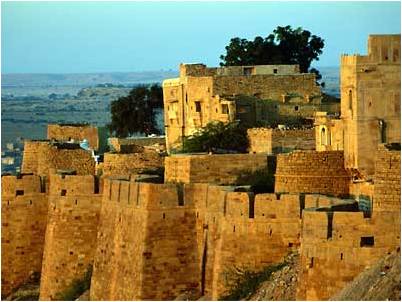
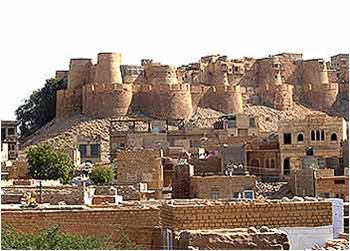
Twelfth-century Jaisalmer Fort, home to a quarter of Jaisalmer’s residents
The majority of the inhabitants of Jaisalmer are Bhati Rajputs, who take their name from an ancestor named Bhatti, renowned as a warrior when the tribe were located in the Punjab. Shortly after this the clan was driven southwards, and found a refuge in the Indian desert, which was henceforth its home.
Deoraj, a famous prince of the Bhati family, is esteemed the real founder of the Jaisalmer dynasty, and with him the title of rawal commenced. In 1156 Rawal Jaisal, the sixth in succession from Deoraj, founded the fort and city of Jaisalmer, and made it his capital as he moved from his former capital at Lodhruva (which is situated about 15 km to the south-east of Jaisalmer).
In 1294, the Bhatis so enraged the emperor Ala-ud-din Khilji that his army captured and sacked the fort and city of Jaisalmer, so that for some time it was quite deserted. After this there is nothing to record till the time of Rawal Sahal Singh, whose reign marks an epoch in Bhati history in that he acknowledged the supremacy of the Mughal emperor Shah Jahan.
The Jaisalmer princes had now arrived at the height of their power, but from this time till the accession of Rawal Mulraj in 1762 the fortunes of the state rapidly declined, and most of its outlying provinces were lost. In 1818 Mulraj entered into political relations with the British. Maharawal Salivahan, born in 1887, succeeded to the chiefship in 1891.
Medieval period
During the Islamic invasion of India, Jaisalmer escaped direct Muslim conquest due to its geographical situation in the desert region. The Rawals of Jaisalmer agreed to pay an annual tribute to the Delhi Sultans. The first siege of Jaisalmer occurred during the reign of Allaud-din Khilji. It was provoked by Bhatis’ raid on a caravan filled with treasure. According to local ballads, the Bhatis defended the fort for seven years until the enemy army forced beached the ramparts. Bhatis, facing certain defeat, proclaimed the rite of jauhar. Later, Sultan Ferozshah also sieged Jaisalmer after the rulers of Jaisalmer raided his camp at Anasagar lake near Ajmer. The siege led to another jauhar. Jaitsimha’s son Duda perished in the attack. Duda’s descendants ruled over Jaisalmer for about two centuries. Duda’s descendant Lunakarna had a fight with Humayun when the latter passed through Jaisalmer en route to Ajmer. Mughal emperor Akbar was married to one of the Jaisalmer princesses.
Jain Temples: The fort of Jaisalmer consists three elegantly engraved Jain Temples devoted to the Jain Tirthankaras – Rikhabdevji and Sambhavnathji. Gyan Bhandar or Library. A few of the oldest manuscripts of India can be discovered in this library set us as a part of Jain temples.
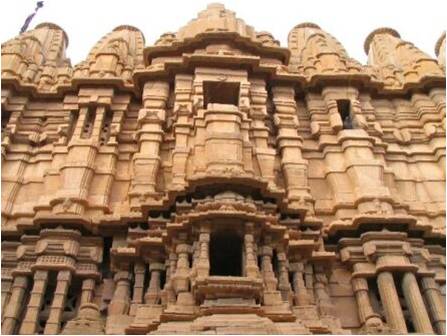
Salim Singh-Ki-Haveli: The residence of the powerful Mohta Family, the hereditary ministers of the Jaisalmer rulers Salim Singh-Ki-Haveli has distinctive blue cupola roof, and a facade, which is engraved all over, and a superb projecting balcony that adorns the top storey.
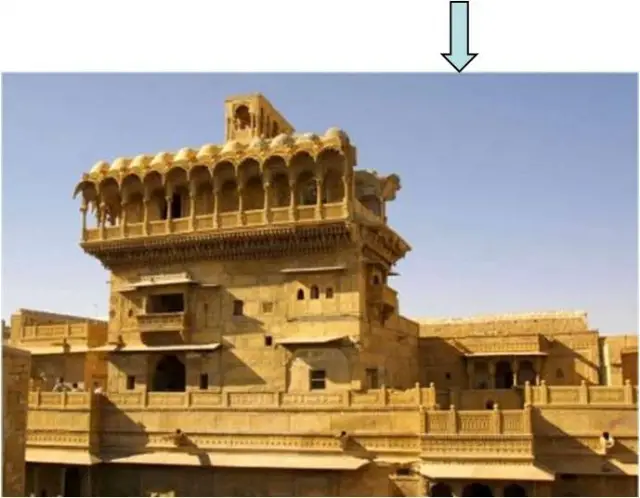
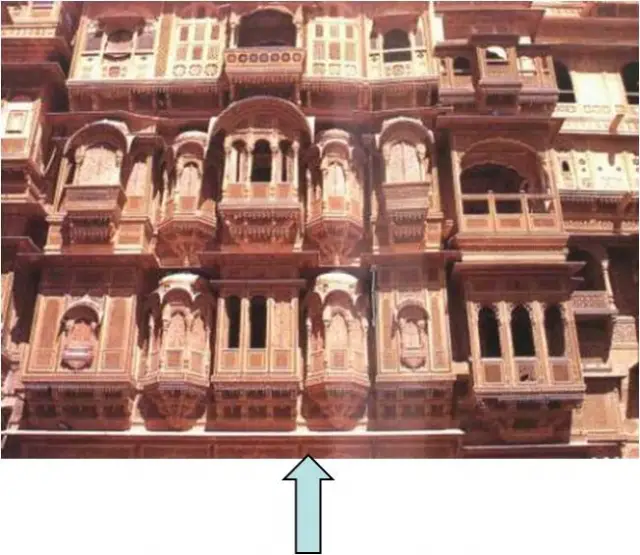
Patwon-Ki-Haveli: This is one of the most elaborate and largest houses in Jaisalmer with five storeys, and comprehensively engraved.
Gadisar Lake: The Gadisar Lake, once the water supply of the city, is surrounded with multitudes of shrines and small temples. The small museum is consisting displays of folk art here.
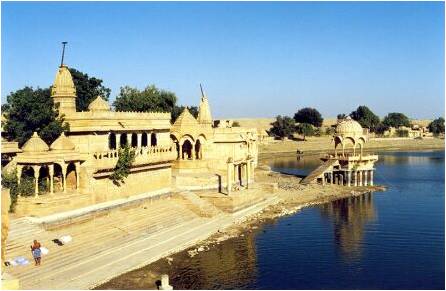
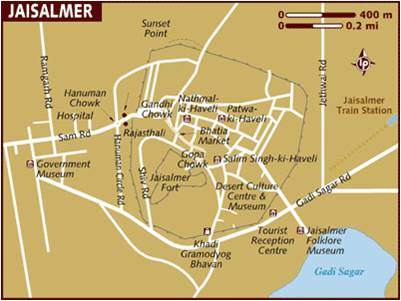
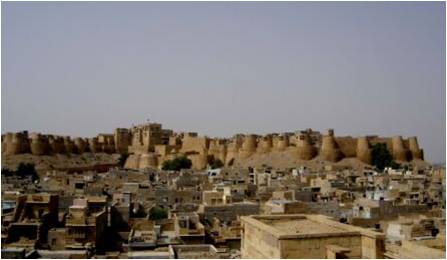
![[filefield-description]](https://www.archinomy.com/wp-content/uploads/case-studies/2011/jaisalmer-4.jpg)
Jaisalmer was one of the last states to sign a treaty with the British. During the British Raj, Jaisalmer was the seat of a princely state of the same name, ruled by the Bhati clan of rajputs. The present descendant is Brijraj Singh. Though the city is under the governance of the Government of India, a lot of welfare work is carried out by him and his family. The Royal Family still commands a lot of respect from the people.[citation needed]
Traditionally, the main source of income was the levies on the caravans. However, the glory of Jaisalmer faded when Bombay emerged as a port and the sea trade replaced the traditional land routes. The partition of India in 1947 lead to closing of all the trade routes on the Indo-Pak border and rendered Jaisalmer a drought-prone desert backwater on the international border. Ironically, skirmishes between India and Pakistan gave Jaisalmer a strategic importance and made it serviceable as an army supply depot. Later, the Rajasthan Canal served to revive the surrounding desert areas. Roads and railroads were then built, knitting the hitherto remote town with the rest of Rajasthan.

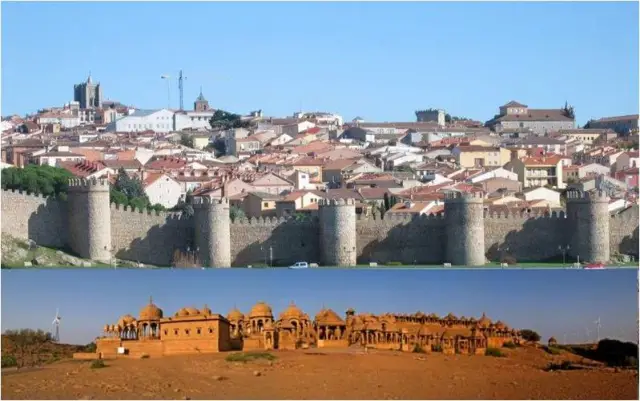
Leave a Reply
You must be logged in to post a comment.